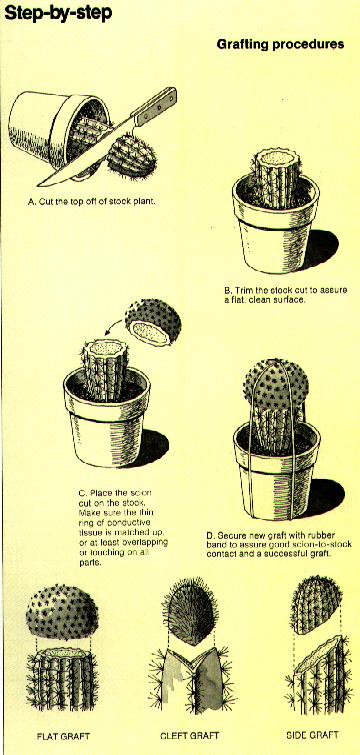The Comprehensive Guide To Grafting
Taken from _The World
of Cactus & Succulents_
from Ortho Books, Copyright
1977
(HTML'd & OCR'd by GluckSpilz HTTP://www.cnw.com/~neuro/gaz/
All Spelling Errors are MINE
Grafting is a procedure that unites two different plants into a single plant.
There are two reasons for grafting: emergency grafting to save the life of the
plant and elective grafting to change the appearance of the plant.
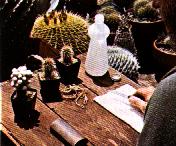
To
Graft: Start with Clean tools &
botanically compatible
plants.
Emergency grafting is done to save a plant with a rotted
root system or lower stem. It might also be necessary for rooting collected
plants which do not root successfully out of their native habitat. Grafting is
valuable as a means of propagating a valuable plant that does not produce
offsets and takes many years to mature, bloom, and set seed.
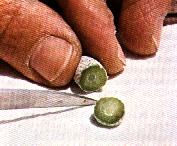
Cut scion
off. Make sure it's smaller
than the understock.
Elective or
cosmetic grafting is used to change the form of the plant or to speed up
propagation of stem cuttings.
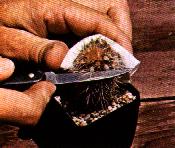
Carefully
cut the top of the understock off;
protect fingers with
padding.
The process itself consists of uniting a scion (stem
cutting) and an understock (the root system) of two different plants. The
understock gives vigor and strength to the weak or slow-rooting scion. The two
plants must be botanically compatible, (from the same botanical family) even
though they are often of different species within a family. You cannot graft a
cactus to a crassula but you can graft one kind of cactus to another kind of
cactus. Plants should be grafted dur- ing their period of growth and never when
the understock is dormant.
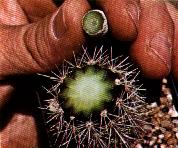
Attach
scion, cut side down, to understock.
Maker sure the union meets
evenly.
The success of the graft depends on three factors: absolute
cleanliness, a close fit between the growth layers of scion and understock, and
main- taining the close union of the two pieces until they have grown together.
It's essential to have the scion and understock closely matched in size in order
to have as much of the cut sur- face of both in contact and to work as quickly
as possible to prevent both callusing and exposure to disease. Have everything
you need assembled and sterilized before you make any cuts. Use sharp tools that
will make a clean, straight cut.
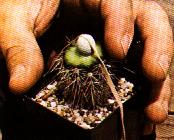
Hold scion
in place with a rubber band
around pot and plant, but not too
tightly.
There are four different types of graft cuts. Which you use
is deter- mined by the size and shape of the plants you're grafting.
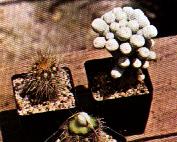
The
understock and the scion "donor"
stand behind the new grafted
plant.
The flat cut is used for thick, globular
scions and is the easiest to do. It is important for the understock to be large
enough to support the scion both at the time of grafting and as both plants
mature. As a general rule, the stock should be a minimum of ten times the weight
of the scion. The scion can be smaller in diameter than the understock but never
larger. Rubber bands are the easiest way to hold flat grafts. Pass the band over
the scion and under the pot on two sides.
Another technique is to insert a strong, pointed spine on both sides of the
understock. Then pass the rubber band over the scion and attach it to the spines
on either side of the under- stock. Toothpicks can also be used but spines have
the advantage of dis- appearing without leaving a mark, while toothpicks leave a
scar. Be sure that the bands are not too tight or the scion will be injured.
Because they are flexible, rubber bands can expand with the growth of the
scion though they typically rot away after growth begins.
The cleft cut is used to give a draping variety an upright
growth habit. Specialist nurseryman Rogers Weld of Fernwood Gardens in South-
ern California uses a hybrid opuntia, 'Mrs. Burbank,' as the understock for a
schlumbergera scion.
The side cut is used for upright, cylindrical plants, and is
almost as easy as the flat graft.
The stab graft is used to unite a schlumbergera to an
opuntia pad by making a cut at the areole of the opuntia and inserting the
schlum- bergera. It is the least common type of graft.
Until a graft has taken, avoid over- head watering; water in the cut is an
open invitation to rot.
